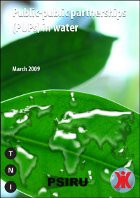Public-public partnerships (PUPs) in water
Out of sight of many global policy-makers, a growing number of public sector water companies have been engaged, in a great variety of ways, in helping others develop the capacity to be effective and accountable public services.

Authors
Introduction
Water operators need to be efficient, accountable, honest public institutions providing a universal service. Many water services however lack the institutional strength, the human resources, the technical expertise and equipment, or the financial or managerial capacity to provide these services. They need support to develop these capacities.
The vast majority of water operators in the world are in the public sector – 90% of all major cities are served by such bodies. This means that the largest pool of experience and expertise, and the great majority of examples of good practice and sound institutions, are to be found in existing public sector water operators. Because they are public sector, however, they do not have any natural commercial incentive to provide international support. Their incentive stems from solidarity, not profit. Since 1990, however, the policies of donors and development banks have focussed on the private companies and their incentives. The vast resources of the public sector have been overlooked, even blocked by pro-private policies.
Out of sight of these global policy-makers, however, a growing number of public sector water companies have been engaged, in a great variety of ways, in helping others develop the capacity to be effective and accountable public services. These supportive arrangements are now called “public-public partnerships” (PUPs). A public-public partnership (PUP) is simply a collaboration between two or more public authorities or organisations, based on solidarity, to improve the capacity and effectiveness of one partner in providing public water or sanitation services. They have been described as: “a peer relationship forged around common values and objectives, which exclude profit-seeking”.1 Neither partner expects a commercial profit, directly or indirectly.
This makes PUPs very different from the public–private partnerships (PPPs) which have been promoted by the international financial institutions (IFIs) like the World Bank. The problems of PPPs have been examined in a number of reports. A great advantage of PUPs is that they avoid the risks of such partnerships: transaction costs, contract failure, renegotiation, the complexities of regulation, commercial opportunism, monopoly pricing, commercial secrecy, currency risk, and lack of public legitimacy.
PUPs are not merely an abstract concept. The list in the annexe to this paper includes over 130 PUPs in around 70 countries. This means that far more countries have hosted PUPs than host PPPs in water – according to a report from PPIAF in December 2008, there are only 44 countries with private participation in water. These PUPs cover a period of over 20 years, and been used in all regions of the world. The earliest date to the 1980s, when the Yokohama Waterworks Bureau first started partnerships to help train staff in other Asian countries. Many of the PUP projects have been initiated in the last few years, a result of the growing recognition of PUPs as a tool for achieving improvements in public water management.
This paper attempts to provide an overview of the typical objectives of PUPs; the different forms of PUPs and partners involved; a series of case studies of actual PUPs; and an examination of the recent WOPs initiative. It then offers recommendations for future development of PUPs.
